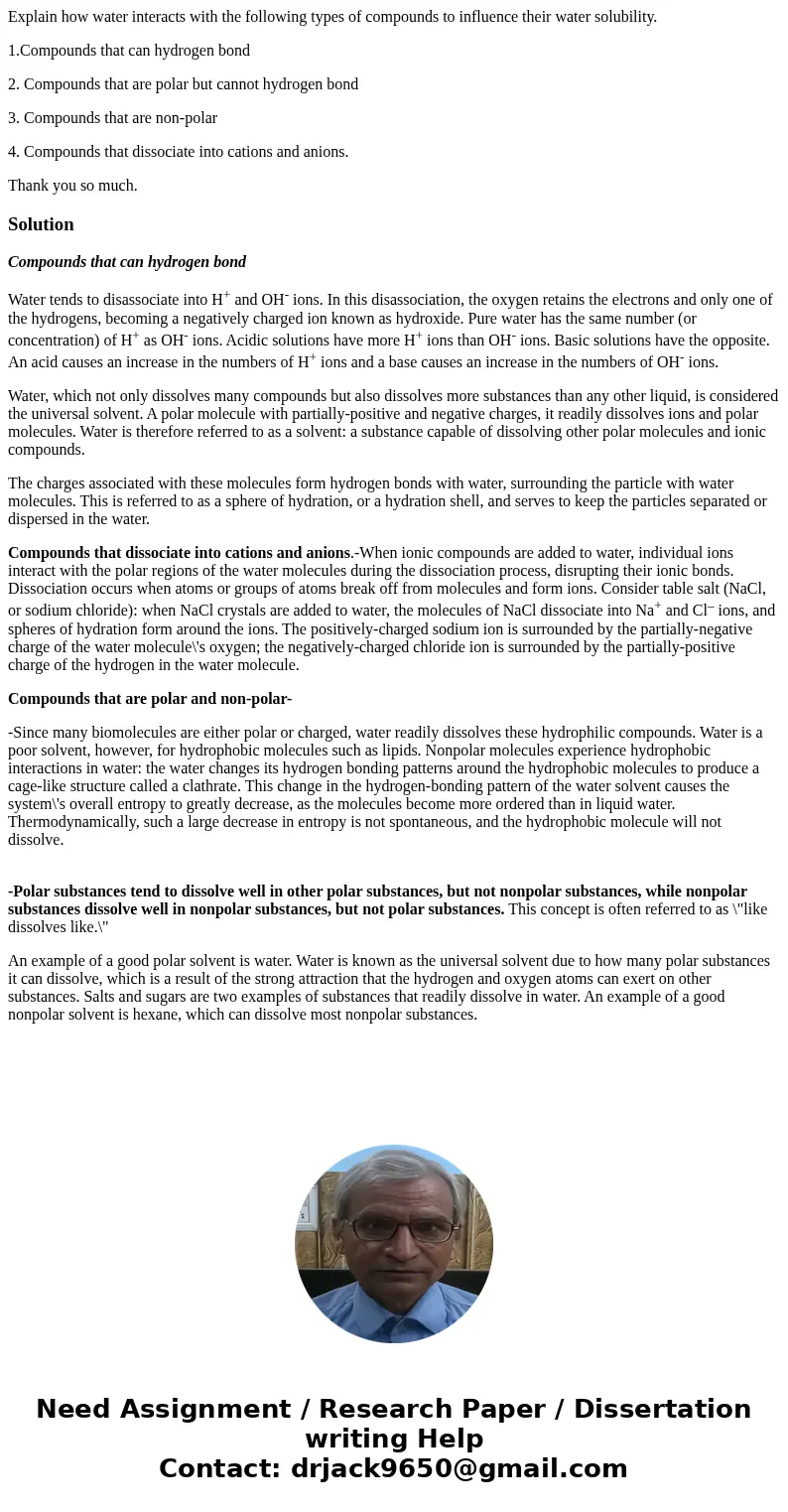Explain how water interacts with the following types of comp
Explain how water interacts with the following types of compounds to influence their water solubility.
1.Compounds that can hydrogen bond
2. Compounds that are polar but cannot hydrogen bond
3. Compounds that are non-polar
4. Compounds that dissociate into cations and anions.
Thank you so much.
Solution
Compounds that can hydrogen bond
Water tends to disassociate into H+ and OH- ions. In this disassociation, the oxygen retains the electrons and only one of the hydrogens, becoming a negatively charged ion known as hydroxide. Pure water has the same number (or concentration) of H+ as OH- ions. Acidic solutions have more H+ ions than OH- ions. Basic solutions have the opposite. An acid causes an increase in the numbers of H+ ions and a base causes an increase in the numbers of OH- ions.
Water, which not only dissolves many compounds but also dissolves more substances than any other liquid, is considered the universal solvent. A polar molecule with partially-positive and negative charges, it readily dissolves ions and polar molecules. Water is therefore referred to as a solvent: a substance capable of dissolving other polar molecules and ionic compounds.
The charges associated with these molecules form hydrogen bonds with water, surrounding the particle with water molecules. This is referred to as a sphere of hydration, or a hydration shell, and serves to keep the particles separated or dispersed in the water.
Compounds that dissociate into cations and anions.-When ionic compounds are added to water, individual ions interact with the polar regions of the water molecules during the dissociation process, disrupting their ionic bonds. Dissociation occurs when atoms or groups of atoms break off from molecules and form ions. Consider table salt (NaCl, or sodium chloride): when NaCl crystals are added to water, the molecules of NaCl dissociate into Na+ and Cl– ions, and spheres of hydration form around the ions. The positively-charged sodium ion is surrounded by the partially-negative charge of the water molecule\'s oxygen; the negatively-charged chloride ion is surrounded by the partially-positive charge of the hydrogen in the water molecule.
Compounds that are polar and non-polar-
-Since many biomolecules are either polar or charged, water readily dissolves these hydrophilic compounds. Water is a poor solvent, however, for hydrophobic molecules such as lipids. Nonpolar molecules experience hydrophobic interactions in water: the water changes its hydrogen bonding patterns around the hydrophobic molecules to produce a cage-like structure called a clathrate. This change in the hydrogen-bonding pattern of the water solvent causes the system\'s overall entropy to greatly decrease, as the molecules become more ordered than in liquid water. Thermodynamically, such a large decrease in entropy is not spontaneous, and the hydrophobic molecule will not dissolve.
-Polar substances tend to dissolve well in other polar substances, but not nonpolar substances, while nonpolar substances dissolve well in nonpolar substances, but not polar substances. This concept is often referred to as \"like dissolves like.\"
An example of a good polar solvent is water. Water is known as the universal solvent due to how many polar substances it can dissolve, which is a result of the strong attraction that the hydrogen and oxygen atoms can exert on other substances. Salts and sugars are two examples of substances that readily dissolve in water. An example of a good nonpolar solvent is hexane, which can dissolve most nonpolar substances.

 Homework Sourse
Homework Sourse